Neil Peart's News, Weather and Sports
Theme and Variations
NeilPeart.net, August 2010
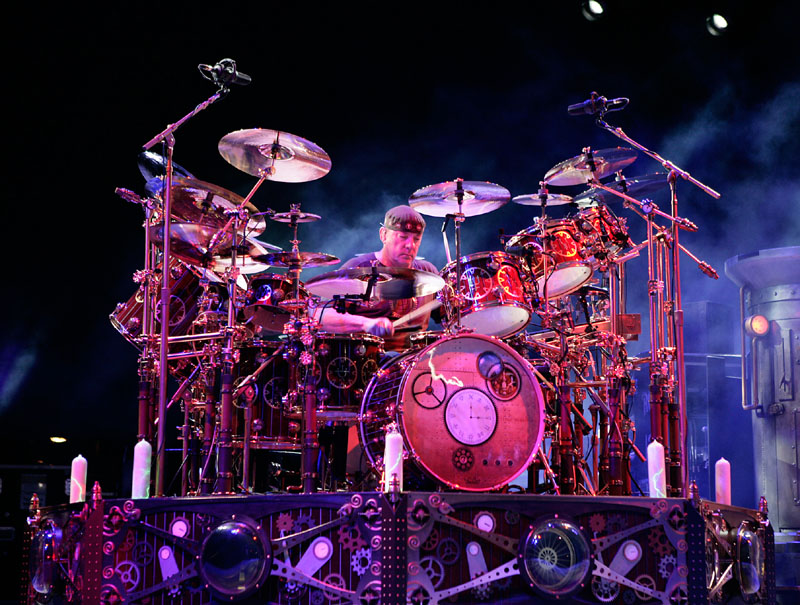
Since at least 2004, during the Thirtieth Anniversary tour I wrote about in Roadshow, I have been talking about a theme for a book, and even chipping away at it (mostly in my head, but partly in these stories). I referred to that imaginary book as Roadcraft: How to Work the World, and the aim was to assemble a set of rules for travelers that deliberately paralleled rules about living, working, making music& - metaphors, like.
However, the more I continued to think about that goal, the more I realized it was not a book you could just sit down and write& - it would have to accumulate, like experience, a journey, a life, and (indulge me here), a drum solo. In the flow of rhythm, dominant patterns arise and gather gravity over time, and suggest parallels that can be further developed and expressed& - variations on a theme.
It has become obvious to me that my ambitions for Roadcraft represent the project of a lifetime, really, to be gathered and shared along the way. And in any case, those observations would certainly demand more than one book& - more than one lifetime. But, what the hey& - I figure I'll just start trying to nail down any principles I can, for as long as I can, then pass the project down to the next generation of travelers ...
I: The Art of Improvisation
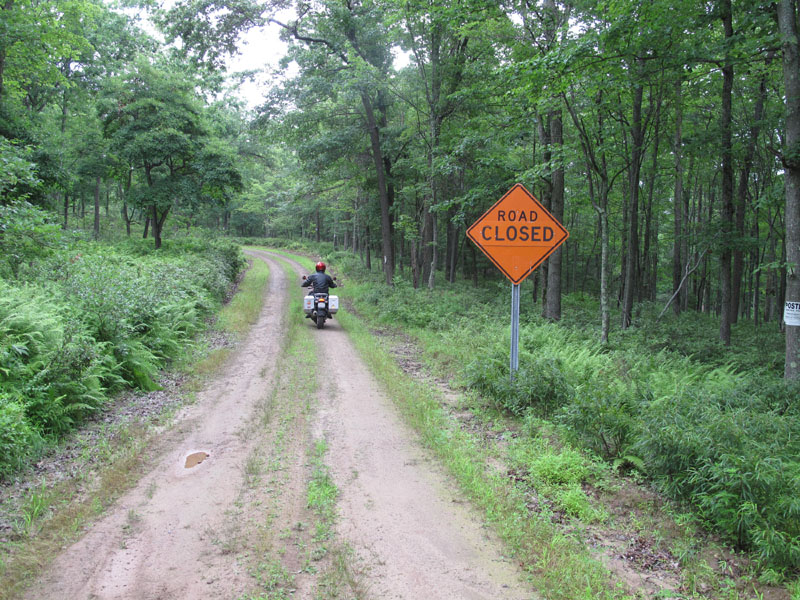
When I see a sign like the one above, I pause and think it over. Should I continue, trusting that I'll find my way through, or should I turn back and find another way?
In such moments of decision (or indecision), a number of factors are weighed and compared, using a combination of imagination and experience. Do the map and GPS agree that this is in fact a "road?" If so, is it really "closed," or just "unmaintained?" My riding partner Michael and I certainly don't mind a challenge, and sometimes enjoy a few obstacles difficult enough to raise our heart rates and pump some adrenaline. But ... will there be an impassable point? A locked gate, a fallen tree, a rockfall, a swampy morass, a wall of snow, or a collapsed bridge? All of those barriers have turned us around in such situations, from California to West Virginia, Oregon to Vermont, because as shunpikers (see "Shunpikin' It Old Skool," September 2007), we deliberately seek out such roads.
When you're riding a heavy motorcycle on a narrow track, it's always better to choose where you're going to turn around, and not have it forced upon you. Your only "reverse gear" is pushing, so you don't want to be pointed downhill against a fence with boulders on both sides. (It happened to me& - but only once.)
Facing a Road Closed sign like that, I will also be weighing how much time I should allow to explore it, if it turns out we have to backtrack and go another way. On days off I don't worry about time so much, but on show days, it is everything. Recently I had to explain my show-day mindset to a friend who wanted me to stop at his house for lunch on the way to work. I coined a new word (a "Neilogism") to describe my feelings on such a day: "I am 'anxty,' which combines 'antsy,' 'anxious,' and 'angst-ridden.' On work days, I really just want to keep moving& - have as good a ride as possible, and arrive in plenty of time."
This particular Road Closed sign greeted us in the woods of Pennsylvania, on our way to a show in Camden, New Jersey (across the Delaware from Philadelphia). But although it was a work day, it was still early morning, and we had only a hundred miles or so to go. I felt we had a little time to mess around, so I waved Michael onward, and we rode away& - into the unknown. The very interesting unknown.
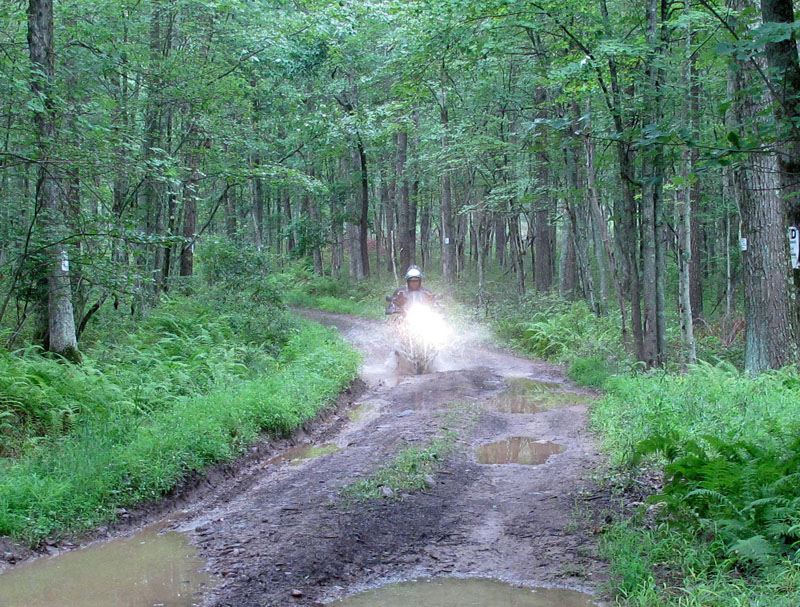
In a sense, Michael and I had been down that road many times before, or ones like it& - but they are all different. We couldn't know if that track would bring us out somewhere in the general direction we were headed& - even though I had traced it on the Rand McNally map of Pennsylvania, where it was marked as an unpaved road, and Michael had found it on his computer GPS program, "Mother," making it part of the route that was then downloaded to our on-bike units, Doofus and Dingus (though those occasionally demented geniuses continued to insist that the muddy track we were on was "Highway 97"). Many different fates have awaited us at such signs before, but hope and optimism carried us forward.
And that day, a fairly common pattern was repeated. At first the road got worse, deteriorating to a muddy, puddled pair of ruts through deep forest, and I began to keep an eye out for turnaround places (a slight uphill is handy). In the photo above, showoff Michael is riding straight into one of those opaque brown puddles, which is photogenic, but generally best avoided& - because it is impossible to read how deep they might be, or what rocks, roots, or ruts might be hidden in their depths. It's best if you can get through by riding between the risky puddles, or beside them. However, that choice puts you in the slippery, equally treacherous grass and ferns, and that terrain requires delicate, precise balance, steering, and throttle use.
After a worrisome couple of miles, there were gradual signs of fresh gravel, a glimpse of a boarded-up hunting cabin through the trees, then a little farther on, a mildewed old mobile home. These habitations indicated at least seasonal use, and finally, all worries were allayed by the sight of an actual house, a small farm, where the track once more became a road that people used, and which led us out to more well-traveled highways.
So ... when I stand before a Road Closed sign, it's all a matter of reading the "signs," literally and metaphorically, and deciding whether I wish to proceed in that direction, while accepting that I may not be able to. That is "Roadcraft," and it occurs to me that I have been finding a musical parallel lately.
This tour I have deliberately designed my drum solo to be more improvisational than ever before, and that has led me into some "adventures" that have their analogues to the art of traveling.
Even as I consider that comparison, it makes me smile& - because sometimes on the drums it absolutely does feel that I'm playing myself into a Road Closed situation, with dark forest all around, treacherous puddles ahead, and an unknown outcome to this rhythmic path I've set myself upon. I can only hope I'll come upon a mobile home and some fresh gravel to lead me back to the "paved road."
Certain wilder places I have ridden, like the African Sahel, or the Sahara, resemble the "map" of my solo. In the open stretches, there may be scores of separate tracks, where cars, trucks, and motorbikes have chosen their own routes. Then at some fixed point& - a ridge in the rocks, or a graveled wash& - all of those paths will come together into an established road.
My solo is built on three rhythmic foundations, which I think of as "The Steampunk Waltz" (freeform melodies and rhythms in ¾ time), "The Steampunk Stomp" (polyrhythms in 4/4 with upbeats against downbeats), and "The Steampunk Mambo" (a Latin ostinato, or repeating rhythm& - regular readers will recall its root in the Italian word for "obstinate," or "stubborn"). Through a couple of different variations, including the electronic drums at the back, I continue to explore and stretch my limits in all of those frameworks, and all of them converge toward the end& - the big-band climax of "Love For Sale."
So, in general, I know where I'm going, but not how I'm going to get there.
Other principles of Roadcraft apply to both drumming and motorcycling& - like a phrase uttered by producer Peter Collins years ago, during the recording of Test For Echo. I was describing to Peter how I had constructed the drum part for "Resist" to be as improvised as possible, by playing along with the song many times and experimenting with all of the elements that might work, especially for the drum fills. Then when I performed that song, like for the recording, all of those ideas were expressed in a random order, different each time. Peter smiled and said, "Don't leave spontaneity to chance." A great observation, and it became a chapter title in my subsequent instructional DVD, A Work in Progress.
The same principle of preparedness as a liberating force is true on the motorcycle. Michael and I rode past that Road Closed sign on capable, well-maintained motorcycles, with good tires. We wore all the protective clothing (I have just read of an acronym for my rule in regard to wearing full riding gear& - helmet, armored suit, gloves, and boots& - on every ride: ATGATT, for "all the gear, all the time." Sadly, us ATGATTs represent a tiny fringe element in the fashion spectrum of motorcycling, but all I can do is stick to what I think is right, and set a good example& - Roadcraft again). Apart from the GPS units, I carried paper maps, plenty of tools, a tire-repair kit, some water, and even a first-aid kit, while Michael added a satellite phone to our "improvisation supplies." So we were properly prepared to make that spontaneous choice.
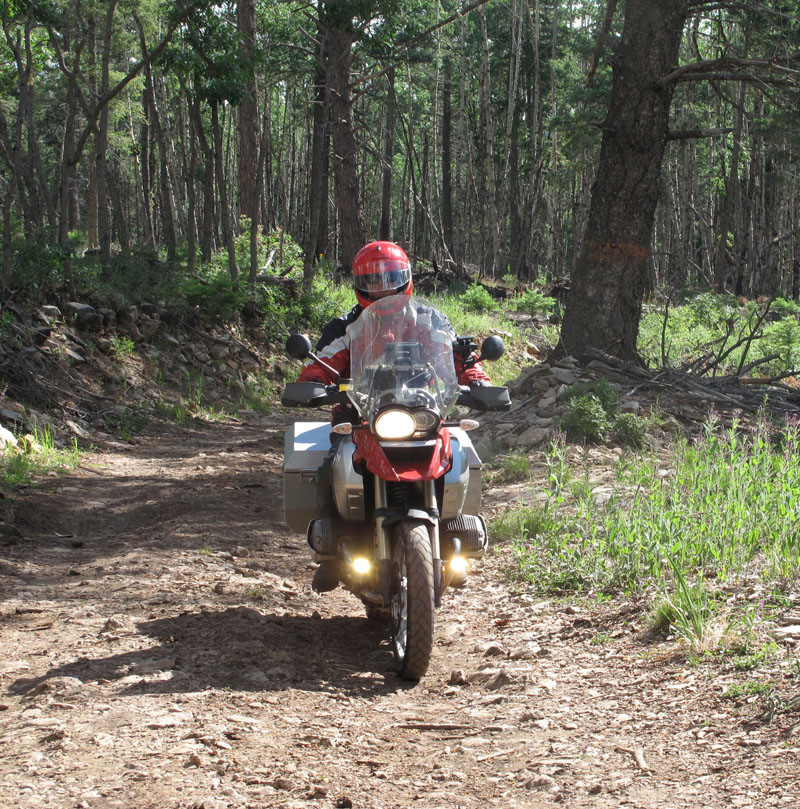
Don't leave spontaneity to chance.
Here is an example of a time when Michael and I were faced with a rapidly worsening track ahead of us& - and took the opposite approach: turned around and got out of there. It was during the full production rehearsals in Albuquerque, when we had a few days to explore the beautiful state of New Mexico. One day off we rode 500 miles around southeast New Mexico, touring Guadalupe Mountains and Carlsbad Caverns National Parks (two new passport stamps for my new journal!), with a nibble of Texas, and curved back north for a night in Artesia. (As a title, that sounds poetic: "A Night in Artesia"& - but the reality was actually a prosaic Best Western with a Chinese buffet& - though decent, and good value, at $11.50 each.) Early the following morning, Michael and I were headed north to Albuquerque for the final rehearsal, with over 300 miles to go. We followed the winding roads up through the Sacramento Mountains near Cloudcroft, at about 9,000 feet, when Doofus and Dingus led us onto this backwoods specimen.
Truth to tell, this photo shows me riding back out the way we had come, after only a few miles in that wilderness. Apart from the sharp rocks that made up the rough logging trail and menaced our tires, the track soon began to descend steeply, into a pine forest that looked sodden, boggy, and forbidding. As mentioned, it's awfully hard to turn a heavy motorcycle when it's pointed downhill on a narrow, muddy track, so I waved Michael to a halt, parked my bike, and walked down for a look. It didn't look promising& - the sharp stones had been bad enough, but the downhill slope was raw, rutted dirt, wet-looking, with football-sized boulders and knotted roots, and the dark sheen of blackwater puddles in the shadows downslope.
I looked back to Michael and shook my head, giving him the "turn around" signal. (And some other signals, too& - we're very profane.) We bounced our way back to the paved highway, and headed down from the cool mountains into the sweltering sagebrush plains, near Trinity Site, the location of the first atomic bomb explosion, in July, 1945& - just weeks before that terrible invention ended that terrible war, in Hiroshima and Nagasaki.
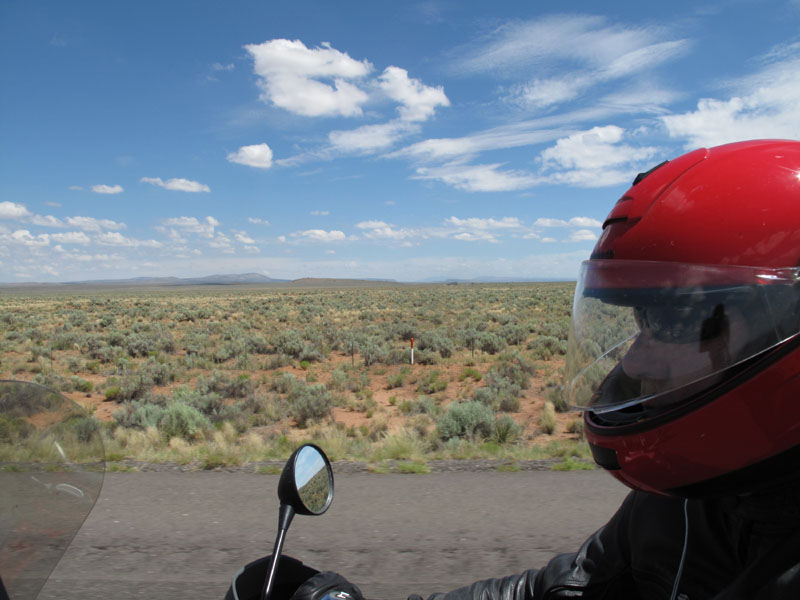
Near the site, we paused at a signboard which quoted Manhattan Project director Robert Oppenheimer's statement on that day, from the Bhagavad Gita, "Now, I am become death, the destroyer of worlds."
Thinking back to both of those little motorcycle adventures, and their different outcomes, the lesson is clear: in Roadcraft, you have to know when to struggle on, and when to make a graceful, planned retreat. Both decisions were "improvised"& - extemporized, invented on the spot, based on experience and imagination& - and both could sometimes be right, and sometimes wrong.
Other times, your progress may be halted by causes in which adaptation to the journey is no longer an option& - because the journey has suddenly halted, and become an entirely different enterprise. Like, for example, if your motorcycle's fuel pump fails in the middle of the busy, speeding traffic of I-40, surrounded by the endless sagelands of eastern Arizona, on an afternoon when the peak temperature of 107°, along the banks of the Colorado at the California-Arizona border, had settled to a steady 100° (as I like to point out, it is indeed a "dry heat," but so is an oven).
That happened on our first day out. After leaving Los Angeles early in the morning, Michael and I had already covered 600 miles, and according to my (always tentative) plan, we would have stopped in another fifty miles or so, in Gallup, New Mexico. (One of my favorite church signs in such cases: "Want to Make God Laugh? Tell Him Your Plans.")
But this setback was only a nuisance& - not a disaster. The first rehearsal would be the following night, so we had allowed plenty of time& - and this was why. (In something over 250,000 miles of riding BMW motorcycles, I have only been stranded that way three times, and two of those& - note to BMW& - were failed fuel pumps.)
As I was riding along in the left lane of I-40, at a decent velocity, passing the many semis and other slow traffic, my bike's power just ceased, suddenly and completely, leaving me coasting, and rapidly losing speed. With a quick glance over my right shoulder, I saw traffic coming up in both lanes behind me, so the safest thing was to signal left and coast into the median. Michael pulled off behind me, and we surveyed the situation. On both sides, steady traffic roared and wailed by, punctuated by the mighty passage of many tractor-trailers on that busy trucking route, each one vibrating the ground and the air around us as they dopplered past.
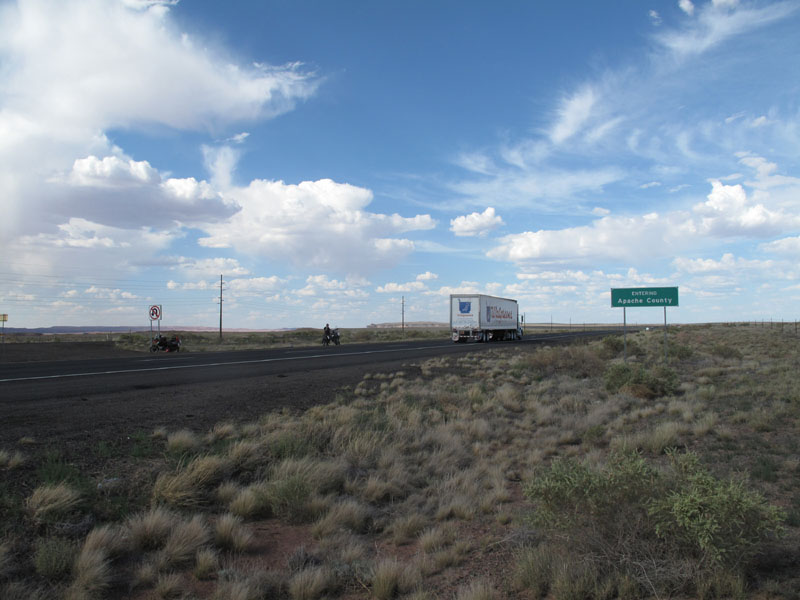
While I had a look over the bike's various mechanical bits, hoping to spot something obvious, like a loose cable or wire, Michael got on the phone to BMW Roadside Assistance.
In these times, with countless satellites in geosynchronous orbit above us, distributing communications and pinpointing navigation for geniuses like Doofus and Dingus, you would think it would be a simple phone call& - "We've broken down at such-and-such latitude and longitude, in the middle of I-40, please send a flatbed." But to my increasing disbelief, as I walked around and photographed our plight, dodging the steady, fast, and loud streams of traffic, I saw the phone stay at Michael's ear. When I looked a question, he said, "I'm on hold." That would continue for long minutes, then he would get another question from the dispatcher: "Have you passed Highway 77 yet?" Another long hold, then, "Have you passed Petrified Forest National Park?" It seemed they were gathering all this information before the flatbed had even started in our direction& - from who knows where, given that we were as near to the middle-of-nowhere as it's possible to get on an interstate in the Continental United States.
Fortunately Michael is cooler-tempered than I am, because that one call went on for an incredible forty-six minutes. Later, I said to him, "Man, I would have been screaming at them, 'We're in the middle of frickin' I-40& - he'll SEE US!!'"
To which Michael replied, "It's hard to scream when you're on hold."
I didn't think so& - but good for him!
Once our situation had became starkly apparent& - we were stranded in the baking desert and could only await rescue& - I accepted that lousy fact, and soon could even think of all the ways it could have been worse.
Michael suggested I take his bike and carry on. He said he would wait for the flatbed and deal with my bike, saying, "It's part of my job, after all."
That was true, in his capacity as my riding partner (though Michael's job also embraces multiple levels of security work for me and the band, as well as being my longtime "Director of Homeland Security" in California). The idea was that if we had a problem on the way to a show, I would take his bike and continue. In fourteen years of doing concert tours by motorcycle, well over 100,000 miles and hundreds of shows, that had never happened& - but it was the reason I always had a riding partner.
However, in this case, I didn't feel like it was an emergency& - a show day& - and in my "traveler's heart," I felt that it was my "situation," so I ought to see it through (the Roadcraft Code).
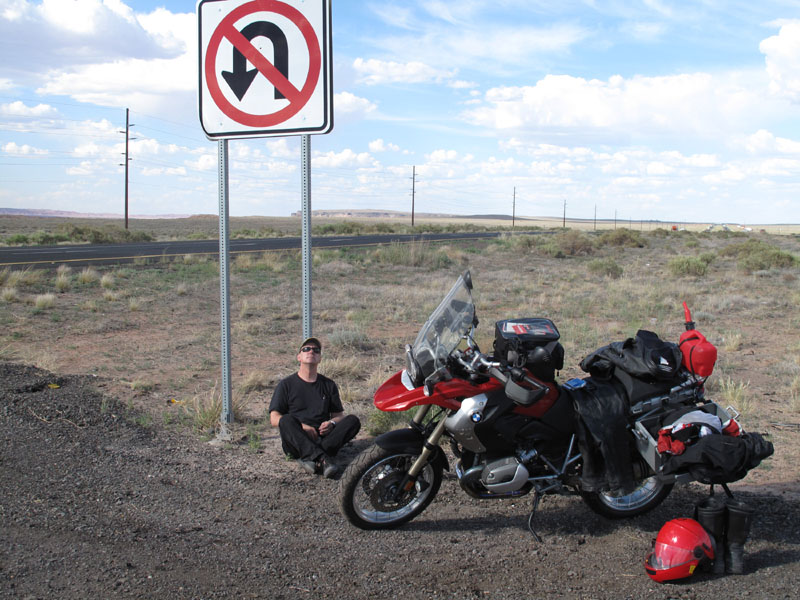
We changed out of our heavy riding suits, and settled down to wait, in the sage, prickly grasses, and talc-dry dust of that shadeless inferno. The "No U-Turn" sign was apt.
An hour went by, and then two. The science of meteorology must offer a formula to multiply two hours by one hundred degrees. Fortunately we had bought sandwiches and water at a truck stop earlier, intending to have a quick lunch at a rest area in Arizona& - but that troubled state, like California and a few others, has been closing its rest areas for "budgetary" reasons (so uncivilized and ungracious to travelers), and we ended up eating in the shadow of an undercrossing beneath I-40& - loud and charmless, but the only shade we could find. But now at least we had some extra water, though it was soon gone.
At one point Michael and I were both huddled in the paltry shade of my motorcycle, and started getting delirious& - on purpose, though, entertaining ourselves and each other. We had dodged a few showers that day, and had seen a few virgas, gray veils of rain that evaporated before they reached the parched ground. A rainbow appeared in the east, and I asked Michael if he'd like to hear one of the stories I had been reading to Olivia in our early morning times together, called What Makes a Rainbow? He said he would, and I recited the tale in which Little Bunny asks his mother how a rainbow is made, and she tells him to ask his friends. The ladybug tells him you can't have a rainbow without red, the color of her wings; the fox tells him he needs orange, like his fur; the grasshopper tells him he needs green; the chick yellow, and so on. Michael listened with his head cocked, then asked, "Is this some kind of inclusionary story?"
I said I guessed it was, and camped it up. "Yeah& - you know, it takes all your friends, of all different colors, to make a rainbow world."
He shook his head and smiled, "That's so gay."
I tossed my head and turned away, "You say that like it's a bad thing."
We received a call from the flatbed driver around that two-hour point, saying he was a half hour away. I started to contemplate the next stage& - my bike would be transported to the BMW dealer in Albuquerque, which was still around 240 miles east. The thought of sitting in the cab of that flatbed with "my new best friend" made me decide what I had to do& - I would "commandeer" Michael's bike after all.
I felt a little bad about it& - but only a little. And not for long.
However ... it was getting toward dark by then, and all day we had noticed the chunks and coils of thick black rubber that littered that interstate, from failed retreaded truck tires (ought to be banned). "Retread gators," I called them, as they could be as big as alligators, and as deadly. We could dodge those gators in daylight, but at night they would be much less visible. In any case, on general principles I don't like to ride at night& - no scenery, and lots more dangers.
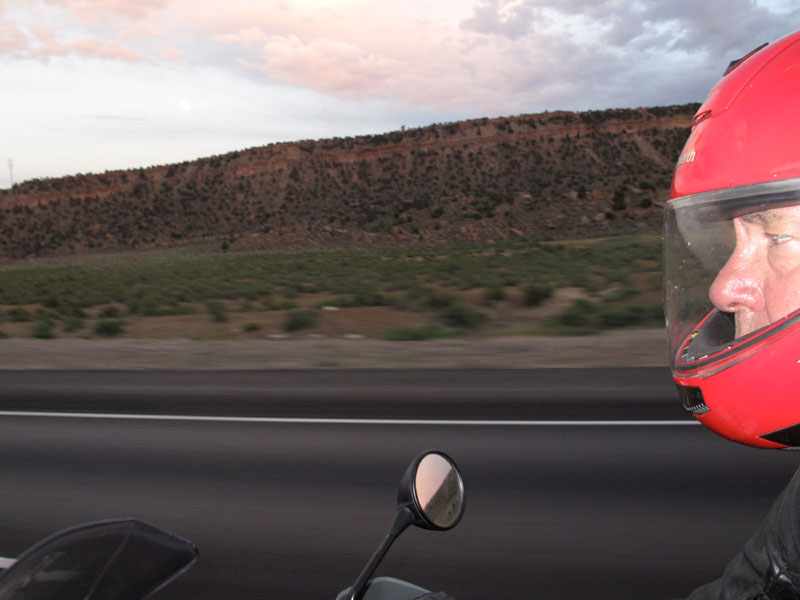
But ... it was time to improvise again.
After this visibly intense portrait in the failing light, I didn't take any more photographs that night& - keeping my concentration riveted on the pavement ahead of me. Even with Michael's good auxiliary lights, I had about two seconds between seeing something and hitting it& - one-Mississippi, two-Mississippi& - so my eyes were fixed on the farthest edge of that ellipse of light. Tense and vigilant, I had the clear thought, "This is an adventure& - and I can't wait 'til it's over."
It ended up being the longest travel day I think I've ever endured& - by the time Michael and I were in my Albuquerque hotel room clicking our plastic cups of Macallan on ice (toasting our arrival with very expressive faces), it was nearly midnight. Including that two-and-a-half-hour "rest" in the middle, it had taken seventeen hours to cover 850 miles.
That is a record I devoutly hope never to break.
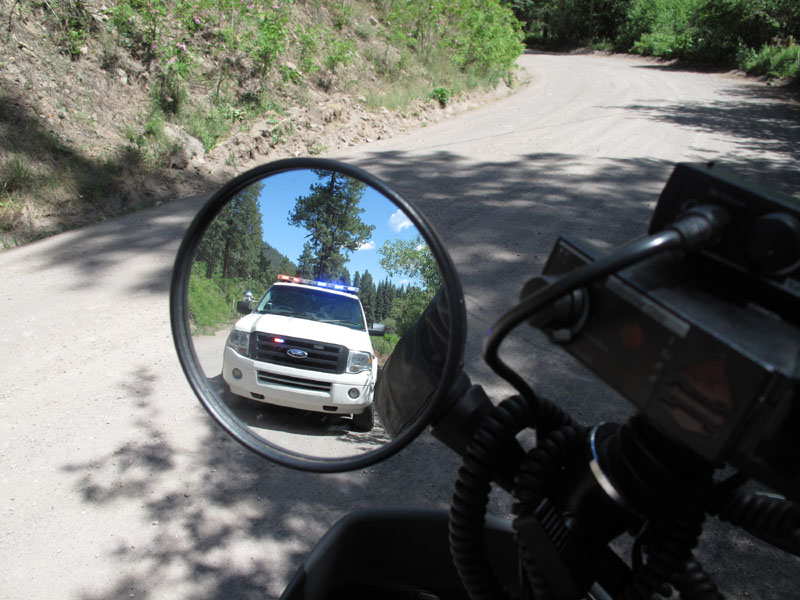
Just as the following is a sight I devoutly hope never to see again (though without faith that it will be so).
It happened two days later, in the Jemez Mountains west of Santa Fe (my motorcycle had been quickly repaired and returned by Sandia BMW), and every time I look at this image it sends the same chilling flash of fear through my insides. However, the real outrage this time was that we were pulled over for speeding& - on a gravel road!
That had never happened before. And, if you note the radar detector perched beside my mirror, we seldom get taken by surprise that way, except in purposely radar-blind speed traps. We heard and saw this guy coming at us& - Michael even waved at him& - then we saw and heard him coming up behind us, lights and siren on. Still, we thought he just wanted to pass us, on his way to some real emergency or crime. But no, he was pulling us over.
He spent the usual long time in his truck, checking our documents, and when he finally got out and went back to speak with Michael, I snuck this photograph. He let us off with what can only be described as a "stern warning," and as Michael and I rode away again, we shook our helmets at each other& - "What the ...?"
Later that day, we talked about our adventures in those first two rides of the tour, and decided that perhaps we had gotten rid of our potential mechanical and legal demons in that first thousand miles. And so it proved, at least for the next 7,500 miles (making the highest total we've ever logged on a single leg of a tour). Thirteen shows, 8,500 miles, three oil changes, two sets of tires& - and a month away from home.
That is the greatest cost of all.
Just before setting off on a concert tour, I am often perplexed when friends at home ask, "Are you excited to be going on tour?"
Of course a deeply ingrained fantasy is at work there, and to answer in the negative seems jaded, cynical, wrong. However, to put their question another way& - should I be excited to be leaving my wife, my ten-month-old daughter, my home, my kitchen, my desk, my books, my pleasures and treasures, my toys and joys?
Another client that Michael works with, Elliot Mintz, is a veteran public relations man, going back to the time of the Beatles, and these days he represents the surviving members of John Lennon's family, Bob Dylan, and other celebrities. A diminutive, nattily-dressed man, he attended one of our shows at the Hollywood Bowl a few years back, and I spoke with him after.
I was telling him that I didn't really like touring, but somehow felt it was something I had to do& - if you call yourself a musician, it is kind of your duty to play live.
He nodded, looked up at me with a serious expression, and said, "You have to do it& - because you can."
That simple phrase stayed with me for a long time after, as I wrestled with its implications. Recently I shared Elliot's insight with Geddy, at dinner in the dressing room before a show, and he nodded and said that statement expressed the reality about as well as he'd ever heard.
A friend of Geddy's was visiting that night, a friend who lived in "the normal world," and he remarked that it seemed like we had a pretty good life.
Geddy said, "Yes, it is a good life& - but it has a price."
Any phrase that includes the words "goes without saying" is suspect, but I would be clear& - I wouldn't trade jobs, or lives, with anyone. In our song "Bravado," there's a fitting line I adapted from John Barth, "We will pay the price, but we will not count the cost."
That cost has many facets& - physical pain, exhaustion, psychological alienation from home, family, and friends, homesickness, performing even when you feel bad, and all the while, missing out on days and nights and countless little events in the lives of your loved ones. A whole part of your life goes on without you. Why the "fantasy" other people imagine doesn't include these elements is because they don't know what it's like to miss those moments of everyday life, so they don't value them highly enough.
But this time the price was made especially sharp for me. Before starting this tour, I had spent nearly every early morning with baby Olivia, all through her ten months of life, quietly watching sunrises together, playing on the floor with her toys and books, sitting side by side on the sofa, my arm around her little form, while I read aloud from What Makes a Rainbow?, Wake Up Little Ones, or Big Red Barn.
Then, after a month away, I returned home to an eleven-month-old baby who didn't know me, shied away from me, and clung to her mother.
I know I just have to hang back until she gets comfortable with me again& - but it still aches.
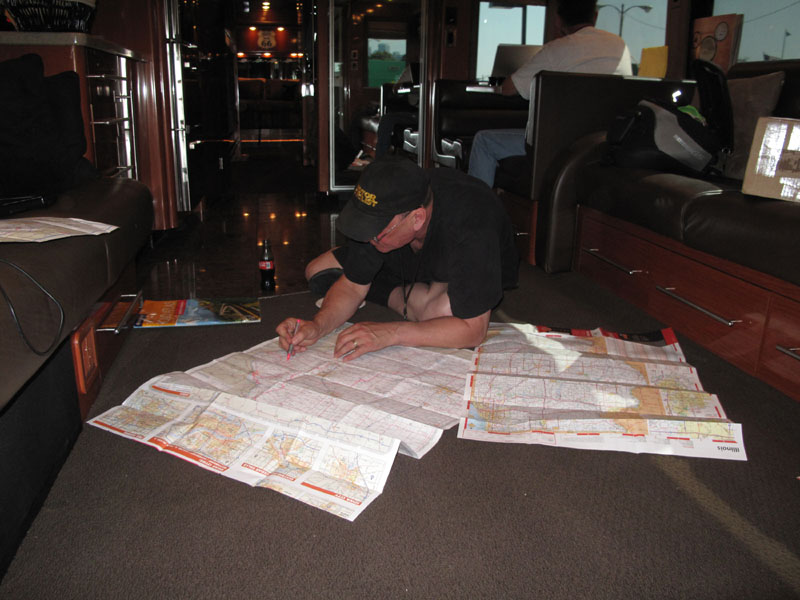
II: Ride For Peace
One reason I like to arrive early on a show day is that there's always so much to do& - bike maintenance, personal maintenance, catching up on e-mails, and, always, getting out the maps and improvising our motorcycle route for the next couple of days& - exploring my way from one show to another, seeking the smallest roads with my pink high-lighter ("Yes Michael, it's pink& - you say that like it's a bad thing"), and stitching them together. In the larger view, I'll try to include a medium-sized town every couple hundred miles, for fuel and possible lunch stops, and consider potential overnight destinations& - towns big enough to have motels and restaurants.
Some of those towns prove to be delightful discoveries in their own right: recently we have had unexpectedly enjoyable nights off in Iowa City, Iowa, Jim Thorpe, Pennsylvania (what a story surrounds that picturesque little town& - I must tell it one day), and several delightful resorts across Ontario and Quebec.
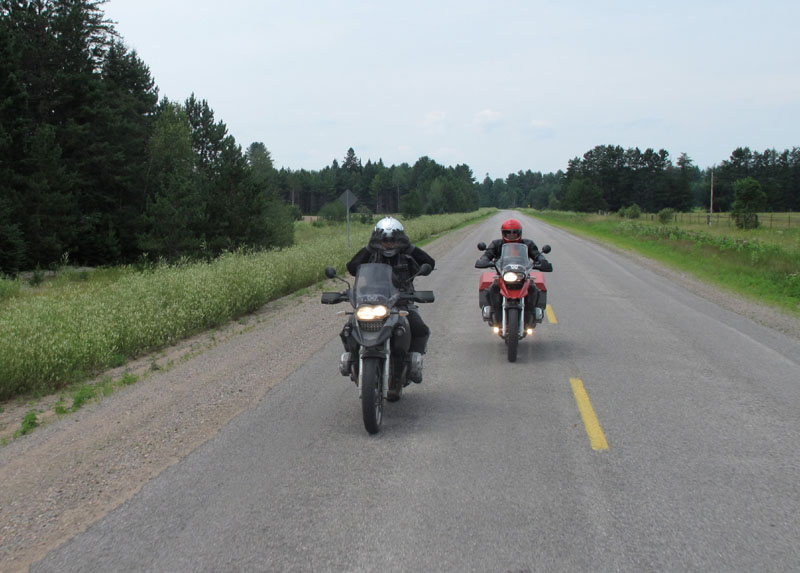
Those last destinations were courtesy of my earliest riding partner, Brutus, who joined Michael and me for the rides to the Canadian shows. With the added tension and social demands of those "hometown" events, it was a pleasure for me to turn the navigation over to Brutus& - a past master at the high art of riffing on a map: improvising. Being conversant with not only paper maps, but with the computer variety, he could also take over Michael's role of tracing the routes on "Mother," then downloading them to the boys& - now reunited as Doofus, Dingus, and Dork.
The average riding temperature on all of those 8,500 miles must have been above 90°, the average only cooled that much by a couple of rainy days. From New Mexico through Kansas to Wisconsin and Ontario, the most common reading on my bike's thermometer seemed to be 95°. Riding into Chicago, and on the way to the last show at Jones Beach on Long Island, I saw and felt 102°& - and it was not a dry heat.
On one such hot afternoon in Ontario, we followed a series of little roads, some paved, some not, framed in green fields and woods. There was almost no traffic, and as I've described such roads before, they were the kind that nobody travels unless they live on them.
A word to describe the mood of that ride came to me& - it felt so peaceful. I would reflect on that word again a few times, on those certain kind of perfect roads that lead from nowhere to nowhere. There is no peace to be found in traffic, on freeways, in towns, and certainly not when I'm playing in front of an audience or bouncing through the night on a roaring bus& - but once in a while, for a few miles every few days, I could feel it.
The same word suggested itself to me in regard to my pre-show warmups, on the small drumset in the Bubba-Gump room. A half-hour before each show, I go in there and just start playing, working out on the same three rhythmic foundations I use in my solo, but without consequences. There is no such thing as a "mistake," never mind a Road Closed, and for fifteen or twenty minutes, I just wander in rhythmic space.
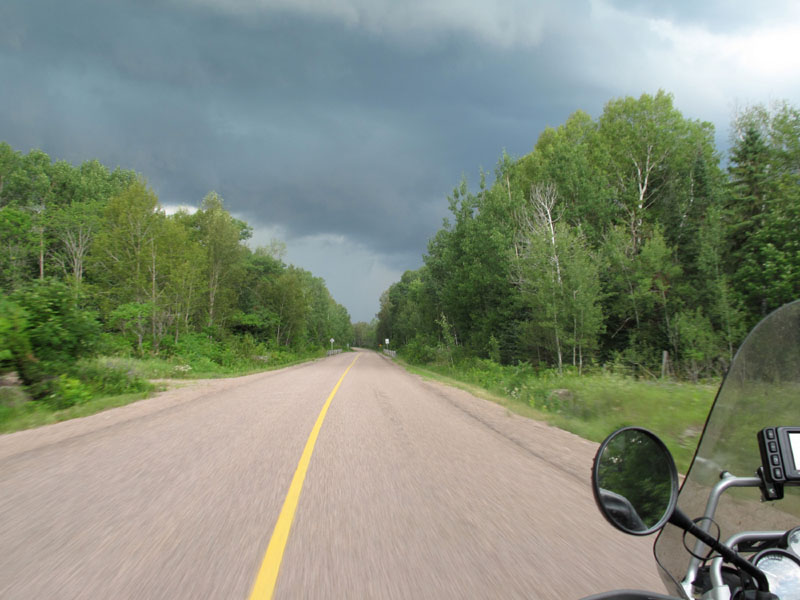
It occurs to me that opposites do not always include a negative, and if "excitement" is one polarity of "peace," it too is a wonderful and necessary component in life. Motorcycling is certainly exciting, but so too is working on a story, or playing the drums& - especially in front of an audience (we had some wonderful audiences at those first thirteen shows, and so many of them, too& - I'll have more to say about that part of the journey in a later story). But even excitement is a tenuous condition& - it can easily tip into anxiety, just as peace can devolve into tedium.
Excitement is found along the road, not at the end, and likeways, peace is not a fixed point& - except perhaps in the unwanted "rest in peace" sense. Peace is the breathing-space between destinations, between excitements, an occasional part of the journey, if you're lucky. Peace is a space you move through very rarely, and very briefly& - but you're not allowed to stay there.
You have to keep moving, and go do what you do.
Because you can ...